Characteristics of Carbonaceous Species in PM2.5 in Wanzhou in the Hinterland of the Three Gorges Reservior of Northeast Chongqing, China
Abstract
:1. Introduction
2. Materials and Methods
2.1. Sampling Site
2.2. Sampling and Analysis
| Sampling Period | Temperature (°C) | Relative Humidity (%) | Wind Speed (m·s−1) | Wind Direction (°) | Total Solar Radiation (w·m−2) | Atmospheric Pressure (v) |
|---|---|---|---|---|---|---|
| January 2013 | 5.2–12.2 (8.3) | 57.6–97.8 (79.6) | 0.50–1.10 (0.67) | 97.3–261.9 (152.7) | 7.5–133.0 (58.2) | 974.5–994.9 (985.9) |
| April 2013 | 15.1–23.2 (18.9) | 66.1–98.0 (80.7) | 0.55–1.56 (0.85) | 91.5–168.0 (124.6) | 16.7–254.2 (125.3) | 968.6–976.0 (982.1) |
| July 2013 | 24.9–33.1 (30.2) | 55.2–98.9 (67.9) | 0.65–1.44 (0.98) | 92.1–162.3 (117.2) | 40.2–309.5 (216.6) | 961.0–967.6 (964.3) |
| October 2013 | 13.5–24.8 (19.6) | 50.0–98.0 (77.6) | 0.57–1.31 (0.72) | 89.5–182.2 (121.2) | 12.0–204.4 (112.0) | 975.1–988.5 (982.2) |
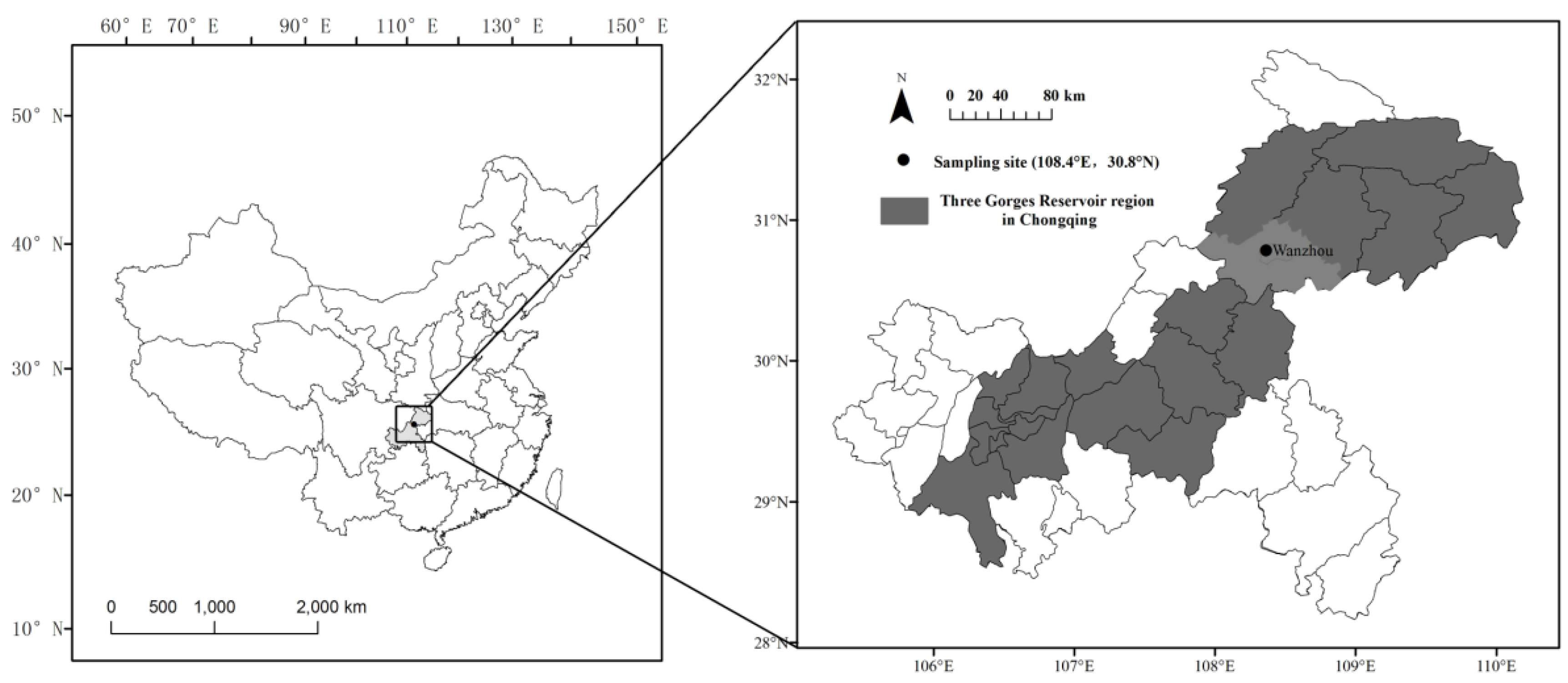
3. Results and Discussion
3.1. PM2.5 Concentrations
| Season | Sample Numbers | PM2.5 Concentration (μg·m−3) | ||
|---|---|---|---|---|
| Min | Max | Average | ||
| Winter | 14 | 104.3 | 483.8 | 236.0 ± 104.5 |
| Spring | 10 | 29.7 | 169.7 | 77.5 ± 48.0 |
| Summer | 14 | 41.7 | 98.7 | 73.4 ± 19.5 |
| Fall | 10 | 72.3 | 188.9 | 114.3 ± 35.4 |
| Total | 48 | 29.7 | 483.8 | 125.3 ± 76.1 |
3.2. Concentrations and Seasonal Variations of OC, EC, and TC
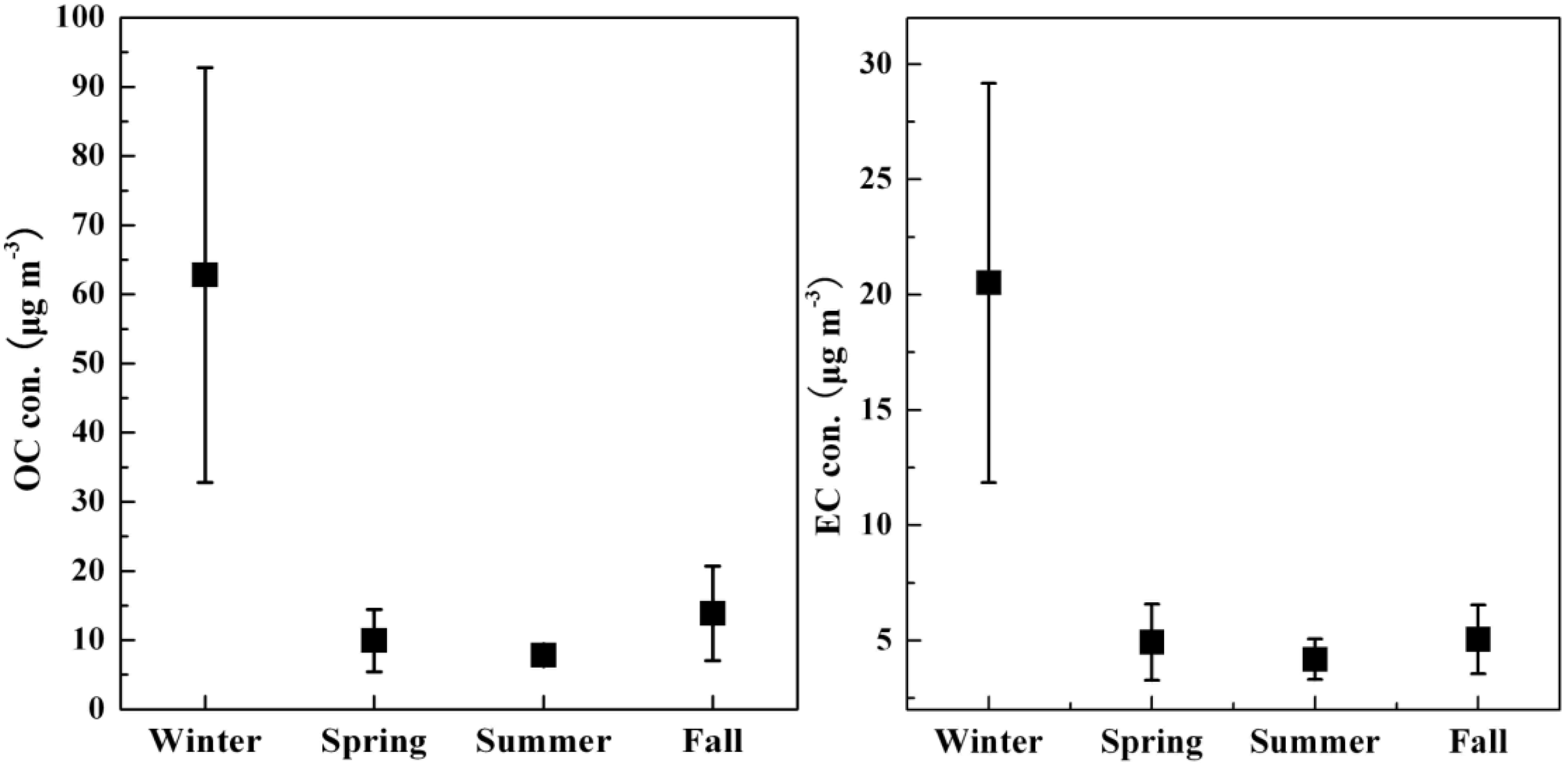
| City | Period | Site Description | OC | EC | TC | OC/EC | Reference |
|---|---|---|---|---|---|---|---|
| Wanzhou, Chongqing | Winter 2013 | Urban commercial-residential-cultural | 62.8 | 20.5 | 83.3 | 3.0 | This study |
| Spring 2013 | 9.9 | 4.9 | 14.9 | 2.1 | This study | ||
| Summer 2013 | 7.9 | 4.2 | 12.9 | 1.6 | This study | ||
| Fall 2013 | 13.9 | 5.1 | 18.1 | 3.3 | This study | ||
| Year 2013 | 23.6 | 8.7 | 32.3 | 2.5 | This study | ||
| Downtown Chongqing | March 2005~February 2006 | Urban residential | 30.1 | 6.4 | 36.5 | 4.7 | [19] |
| Tongliang, Chongqing | March 2002~February 2003 | Urban commercial/residential | 30.8~42.6 | 9.70~12.2 | 40.5~54.7 | 3.2~3.5 | [20] |
| Beijing | Winter, 24 September 1999~28 September 2000 | Urban kerbside | 31.5 | 11.1 | 42.6 | 2.8 | [21] |
| Spring, 24 September 1999~28 September 2000 | 18.2 | 6.7 | 24.9 | 2.7 | [21] | ||
| Summer, 24 September 1999~28 September 2000 | 13.4 | 6.3 | 19.7 | 2.1 | [21] | ||
| Fall, 24 September 1999~28 September 2000 | 28.8 | 10.2 | 39.0 | 2.8 | [21] | ||
| Year | 23.0 | 8.6 | 31.5 | 2.6 | [21] | ||
| Tianjin | Winter 2008 | Urban commercial-residential | 22.9 | 5.6 | 28.5 | 3.8 | [22] |
| Spring 2008 | 14.4 | 5.0 | 19.4 | 3.0 | [22] | ||
| Summer 2008 | 10.2 | 5.5 | 15.7 | 1.8 | [22] | ||
| Fall 2008 | 20.2 | 6.5 | 22.6 | 2.8 | [22] | ||
| Year | 16.9 | 5.7 | 21.6 | 2.9 | [22] | ||
| Zhengzhou | Spring 2010 | Urban industrial | 15.4 | 3.0 | 18.4 | 5.1 | [23] |
| Summer 2010 | 10.0 | 1.8 | 11.8 | 5.6 | [23] | ||
| Fall 2010 | 18.7 | 5.4 | 24.1 | 3.5 | [23] | ||
| Winter 2010 | 27.1 | 4.7 | 31.8 | 5.8 | [23] | ||
| Year 2010 | 17.8 | 3.7 | 21.5 | 5.0 | [23] | ||
| Xiamen | Spring, April 2009 | Urban residential-traffic-commercial | 12.9 | 2.2 | 15.1 | 6.2 | [24] |
| Summer, July 2009 | 9.9 | 2.3 | 12.2 | 4.4 | [24] | ||
| Fall, October 2009 | 24.2 | 3.7 | 27.9 | 6.6 | [24] | ||
| Winter, January 2010 | 30.1 | 5.0 | 35.1 | 6.1 | [24] | ||
| Year 2009 | 19.3 | 3.3 | 22.6 | 5.8 | [24] | ||
| Taiyuan | Winter, December 2005, January–February 2006 | Urban residential-traffic | 28.9 | 4.8 | 33.5 | 7.0 | [25] |
| Xi’an | Winter 2003 | Urban residential | 61.9 | 12.3 | 74.2 | 5.1 | [26] |
| Fall 2003 | 34.1 | 11.3 | 45.4 | 3.3 | [26] | ||
| Shanghai | October 2005–February 2006 | Urban residential-traffic-commercial | 14.7 | 2.8 | 17.5 | 5.0 | [27] |
| Guangzhou | July-November 2002 | Urban residential | 21.4 | 5.7 | 27.1 | 3.8 | [28] |
| Nanjing | February–September 2001 | Urban core | 13.2 | 3.7 | 16.9 | 3.6 | [29] |
| Hong Kong | August 2004–March 2005 | Near city industrial | 12.0 | 3.4 | 15.4 | 3.5 | [30] |
3.3. Relationship between OC and EC
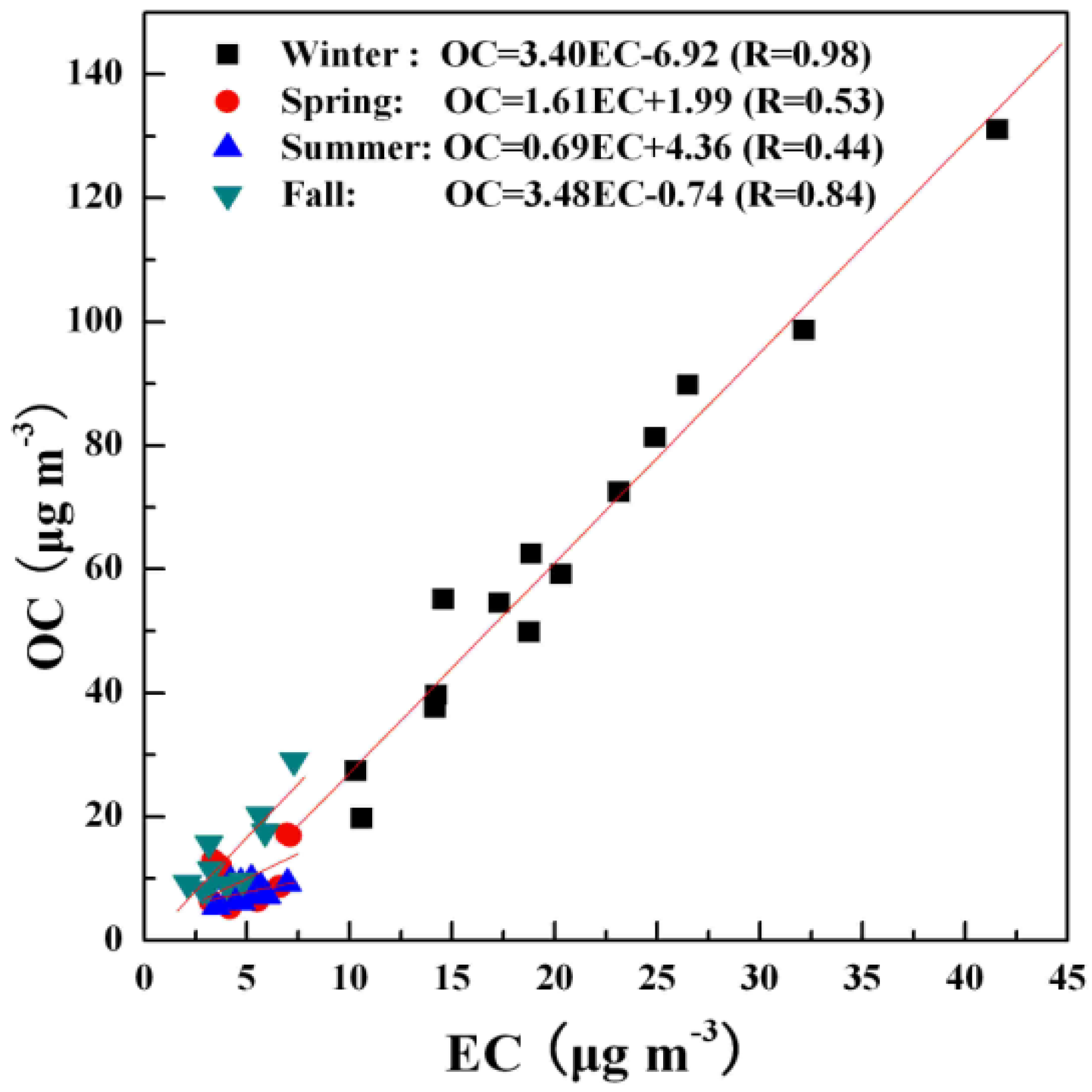
3.4. Estimation of the SOC Concentration
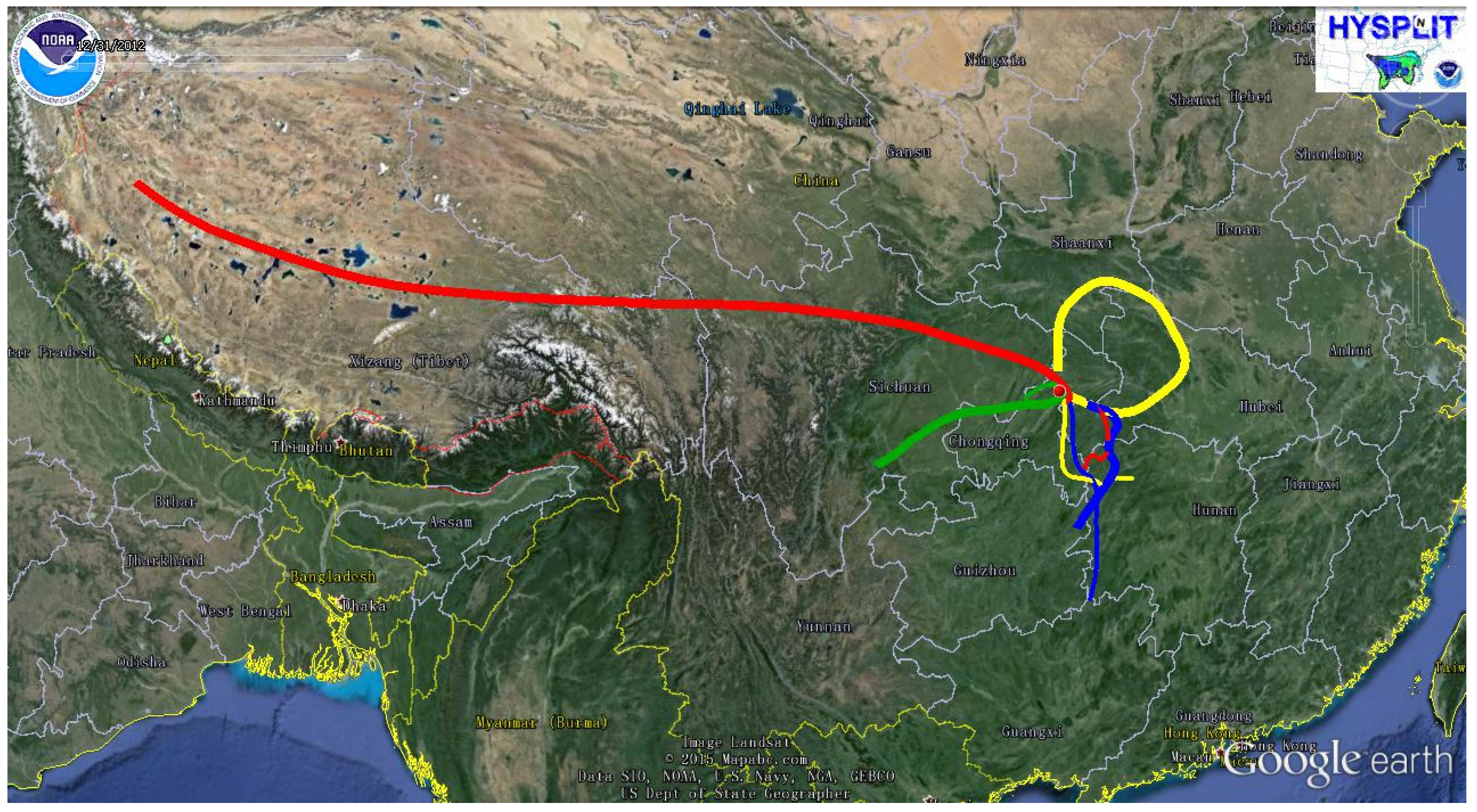
| Season | SOC (μg·m−3) | SOC/OC (%) | TCA a (μg·m−3) | TCA/PM2.5 (%) | SOA b (μg·m−3) | SOA/PM2.5 (%) | OC/PM2.5 (%) | EC/PM2.5 (%) |
|---|---|---|---|---|---|---|---|---|
| Winter | 24.6 ± 14.5 | 38.9 ± 6.5 | 121.0 ± 56.5 | 50.9 ± 6.7 | 39.4 ± 23.2 | 15.7 ± 5.6 | 26.3 ± 3.8 | 8.9 ± 1.1 |
| Spring | 4.2 ± 3.9 | 34.3 ± 24.8 | 26.4 ± 12.3 | 23.1 ± 7.4 | 6.6 ± 6.2 | 7.4 ± 4.9 | 14.3 ± 4.1 | 8.3 ± 4.4 |
| Summer | 1.7 ± 1.3 | 20.8 ± 13.1 | 17.6 ± 2.7 | 25.1 ± 6.0 | 2.8 ± 2.1 | 3.8 ± 2..6 | 11.2 ± 2.6 | 7.3 ± 2.1 |
| Fall | 5.4 ± 4.4 | 35.0 ± 18.9 | 20.8 ± 8.1 | 31.2 ± 10.4 | 8.6 ± 7.1 | 7.0 ± 5.1 | 12.1 ± 4.1 | 3.8 ± 1.3 |
| Year | 9.0 ± 10.5 | 32.3 ± 7.9 | 46.5 ± 49.8 | 32.6 ± 12.7 | 14.4 ± 16.9 | 8.5 ± 5.1 | 16.0 ± 7.0 | 7.1 ± 2.3 |
3.5. OC, EC and TCA Contributions to PM2.5
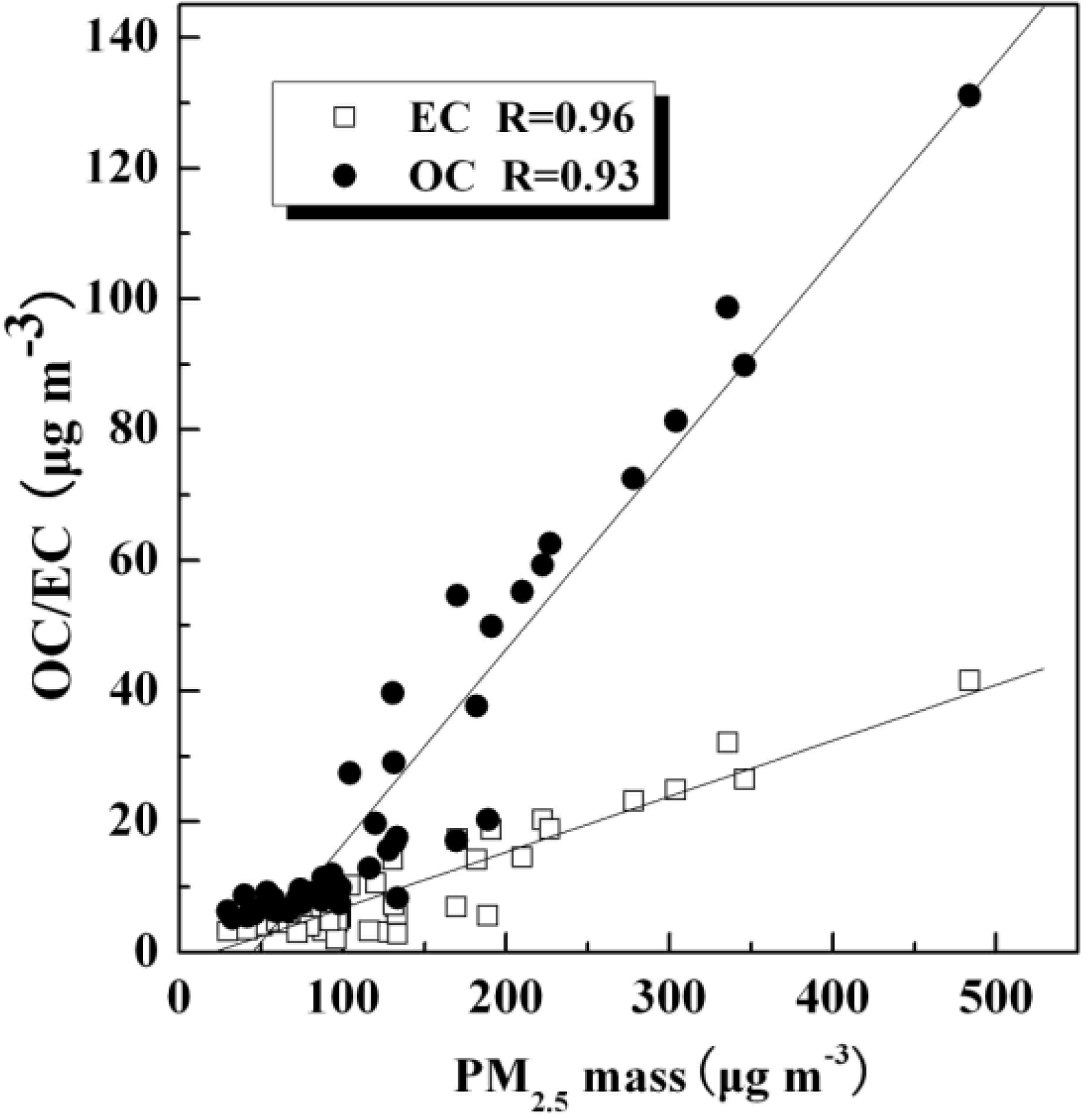
4. Conclusions
Acknowledgements
Author Contributions
Conflicts of Interest
References
- Zhang, M.; Ma, Y.Y.; Gong, W.; Zhu, Z.G. Aerosol optical properties of a haze episode in Wuhan based on ground-based and satellite observations. Atmosphere 2014, 5, 699–719. [Google Scholar] [CrossRef]
- Yang, F.; He, K.; Ma, Y.; Zhang, Q.; Cadle, S.H.; Chan, T.; Mulawa, P.A. Characterization of carbonaceous species of ambient PM2.5 in Beijing, China. J. Air Waste Manage. Assoc. 2005, 77, 984–992. [Google Scholar] [CrossRef]
- Yang, F.; Huang, L.; Duan, F.; Zhang, W.; He, K.; Ma, Y.; Brook, J.R.; Tan, J.; Zhao, Q.; Cheng, Y.; et al. Carbonaceous species in PM2.5 at a pair of rural/urban sites in Beijing, 2005–2008. Atmos. Chem. Phys. 2011, 11, 7893–7903. [Google Scholar] [CrossRef]
- Bond, T.C.; Streets, D.G.; Yarber, K.F.; Nelson, S.M.; Woo, J.H.; Klimont, Z. A technology-based global inventory of black and organic carbon emissions from combustion. J. Geophys. Res. 2004, 109, D14203. [Google Scholar] [CrossRef]
- Jacobson, M.Z. Control of fossil-fuel particulate black carbon and organic matter, possibly the most effective method of slowing global warming. J. Geophys. Res. 2002. [Google Scholar] [CrossRef]
- Ramanathan, V.; Carmichael, G. Global and regional climate changes due to black carbon. Nat. Geosci. 2008, 1, 221–227. [Google Scholar] [CrossRef]
- Menon, S.; Hansen, J.; Nazarenko, L.; Luo, Y.F. Climate effects of black carbon aerosols in China and India. Science 2002, 297, 2250–2253. [Google Scholar] [CrossRef] [PubMed]
- Chameides, W.L.; Yu, H.; Liu, S.C.; Bergin, M.; Zhou, X.; Mearns, L.; Wang, G.; Kiang, C.S.; Saylor, R.D.; Luo, C.; et al. Case study of the effects of atmospheric aerosols and regional haze on agriculture: An opportunity to enhance crop yields in China through emission controls? Proc. Natl. Acad. Sci. USA 1999, 96, 13626–13633. [Google Scholar] [CrossRef] [PubMed]
- Duan, F.; He, K.; Ma, Y.; Jia, Y.T.; Yang, F.M.; Lei, Y.; Tanaka, S.; Okuta, T. Characteristics of carbonaceous aerosols in Beijing, China. Chemosphere 2005, 60, 355–364. [Google Scholar] [CrossRef] [PubMed]
- Xiao, G.; Wang, Z.; Chen, J.; Qiu, Z.; Li, Y.; Qi, J.; Liu, W.; Shu, W. Occurrence and infection risk of waterborne pathogens in Wanzhou watershed of the Three Gorges Reservoir, China. J. Environ. Sci. 2013, 25, 1913–1924. [Google Scholar] [CrossRef]
- Xiao, G.S.; Qiu, Z.Q.; Qi, J.S.; Chen, J.A.; Liu, F.D.; Liu, W.Y.; Luo, J.H.; Shu, W.Q. Occurrence and potential health risk of Cryptosporidium and Giardia in the Three Gorges Reservoir, China. Water Res. 2013, 47, 2431–2445. [Google Scholar] [CrossRef] [PubMed]
- Fu, C.; Guo, J.S.; Pan, J.; Qi, J.S.; Zhou, W.S. Potential ecological risk assessment of heavy metal pollution in sediments of the Yangtze River within the Wanzhou Section, China. Biol. Trace Elem. Res. 2009, 129, 270–277. [Google Scholar] [CrossRef] [PubMed]
- Lin, J.; Fu, C.; Zhang, X.; Xie, K.; Yu, Z. Heavy metal contamination in the water-level fluctuating zone of the Yangtze River within Wanzhou Section, China. Biol. Trace Elem. Res. 2012, 145, 268–272. [Google Scholar] [CrossRef] [PubMed]
- Determination of Atmospheric Particles PM10 and PM2.5 in Ambient Air by Gravimetric Method. Available online: http://kjs.mep.gov.cn/hjbhbz/bzwb/dqhjbh/jcgfffbz/201109/W020120130460791166784.pdf (accessed on 8 April 2015). (In Chinese).
- Chi, X.G.; Di, Y.A.; Dong, S.P.; Liu, X.D. Determination of organic carbon and elemental carbon in atmospheric aerosol samples. Environ. Monit. China 1999, 15, 11–13. (In Chinese) [Google Scholar]
- Watson, J.G.; Chow, J.C.; Antony Chen, L.W. Summary of organic and elemental carbon/black carbon analysis methods and intercomparisons. Aerosol Air Qual. Res. 2005, 5, 65–102. [Google Scholar]
- Duan, F.K.; He, K.B.; Ma, Y.L.; Yang, F.M.; Yu, X.C.; Cadle, S.H.; Chan, T.; Mulawa, P.A. Concentration and chemical characteristics of PM2.5 in Beijing, China: 2001–2002. Sci. Total Environ. 2006, 355, 264–275. [Google Scholar] [CrossRef] [PubMed]
- Feng, Y.C.; Xue, Y.H.; Chen, X.H.; Wu, J.H.; Zhu, T.; Bai, Z.P.; Fu, S.T.; Gu, C.J. Source apportionment of ambient total suspended particulates and coarse particulate matter in urban areas of Jiaozuo, China. J. Air Waste Manag. Assoc. 2007, 57, 561–575. [Google Scholar] [CrossRef] [PubMed]
- Yang, F.; Tan, J.; Zhao, Q.; Du, Z.; He, K.; Ma, Y.; Duan, F.; Chen, G.; Zhao, Q. Characteristics of PM2.5 speciation in representative megacities and across China. Atmo. Chem. Phys. 2011, 11, 5207–5219. [Google Scholar] [CrossRef]
- Chow, J.C.; Watson, J.G.; Chen, L.A.; Ho, S.S.H.; Koracin, D.; Zielinska, B.; Tang, D.L.; Perera, F.; Cao, J.J.; Lee, S.C.; et al. Exposure to PM2.5 and PAHs from the Tong Liang, China epidemiological study. J. Environ. Sci. Health Part A 2006, 41, 517–542. [Google Scholar] [CrossRef]
- He, K.B.; Yang, F.M.; Ma, Y.L.; Zhang, Q.; Yao, X.H.; Chan, C.K.; Cadle, S.; Chan, T.; Mulawa, P. The characteristics of PM2.5 in Beijing, China. Atmos. Environ. 2001, 35, 4959–4970. [Google Scholar] [CrossRef]
- Gu, J.X.; Bai, Z.P.; Liu, A.X.; Wu, L.P.; Xie, Y.Y.; Li, W.F.; Dong, H.Y.; Zhang, X. Characterization of Atmospheric organic carbon and element carbon of PM2.5 and PM10 at Tianjin, China. Aerosol Air Qual. Res. 2010, 10, 167–176. [Google Scholar]
- Geng, N.B.; Wang, J.; Xu, Y.F.; Zhang, W.D.; Chen, C.; Zhang, R.Q. PM2.5 in an industrial district of Zhengzhou, China: Chemical composition and source apportionment. Particuology 2013, 11, 99–109. [Google Scholar] [CrossRef]
- Zhang, F.W.; Zhao, J.P.; Chen, J.S.; Xu, Y.; Xu, L.L. Pollution characteristics of organic and elemental carbon in PM2.5 in Xiamen, China. J. Environ. Sci. 2011, 23, 1342–1349. [Google Scholar] [CrossRef]
- Meng, Z.Y.; Jiang, X.M.; Yan, P.; Lin, W.L.; Zhang, H.D.; Wang, Y. Characteristics and sources of PM2.5 and carbonaceous species during winter in taiyuan, China. Atmos. Environ. 2007, 41, 6901–6908. [Google Scholar] [CrossRef]
- Cao, J.J.; Wu, F.; Chow, J.C.; Lee, S.C.; Li, Y.; Chen, S.W.; An, Z.S.; Fung, K.K.; Watson, J.G.; Zhu, C.S.; et al. Characterization and source apportionment of atmospheric organic and elemental carbon during fall and winter of 2003 in Xi’an, China. Atmos. Chem. Phys. 2005, 5, 3127–3137. [Google Scholar] [CrossRef]
- Feng, Y.L.; Chen, Y.J.; Guo, H.; Zhi, G.R.; Xiong, S.C.; Li, J.; Sheng, G.Y.; Fu, J.M. Characteristics of organic and elemental carbon in PM2.5 samples in Shanghai, China. Atmos. Res. 2009, 92, 434–442. [Google Scholar] [CrossRef]
- Feng, J.L.; Hu, M.; Chan, C.K.; Lau, P.S.; Fang, M.; He, L.Y.; Tang, X.Y. A comparative study of the organic matter in PM2.5 from three Chinese megacities in three different climatic zones. Atmos. Environ. 2006, 40, 3983–3994. [Google Scholar] [CrossRef]
- Yang, H.; Yu, J.Z.; Ho, S.S.H.; Xu, J.H.; Wu, W.S.; Wan, C.H.; Wang, X.D.; Wang, X.R.; Wang, L.S. The chemical composition of inorganic and carbonaceous materials in PM2.5 in Ningjing, China. Atmos. Environ. 2005, 39, 3735–3749. [Google Scholar] [CrossRef]
- Duan, J.C.; Tan, J.H.; Cheng, D.X.; Bi, X.H.; Deng, W.J.; Sheng, G.Y.; Fu, J.M.; Wong, M.H. Sources and characteristics of carbonaceous aerosol in two largest cities in Pearl River Delta Region, China. Atmos. Environ. 2007, 41, 2895–2903. [Google Scholar] [CrossRef]
- Tao, J.; Cheng, T.T.; Zhang, R.J.; Cao, J.J.; Zhu, L.H.; Wang, Q.Y.; Luo, L.; Zhang, L.M. Chemical composition of PM2.5 at an urban site of Chengdu in southwestern China. Adv. Atmos. Sci. 2013, 30, 1070–1084. [Google Scholar] [CrossRef]
- Sheehan, P.E.; Bowman, F.M. Estimated effects of temperature on secondary organic aerosol concentrations. Environ. Sci. Technol. 2001, 35, 2129–2135. [Google Scholar] [CrossRef] [PubMed]
- Blando, J.D.; Turpin, B.J. Secondary organic aerosol formation in cloud and fog droplets: A literature evaluation of plausibility. Atmos. Environ. 2000, 34, 1623–1632. [Google Scholar] [CrossRef]
- Castro, L.M.; Pio, C.A.; Harrison, R.M.; Smith, D.J.T. Carbonaceous Aerosol in Urban and Rural European Atmospheres: Estimation of Secondary Organic Carbon Concentrations. Atmos. Environ. 1999, 33, 2771–2781. [Google Scholar] [CrossRef]
- Turpin, B.J.; Lim, H.J. Species contributions to PM2.5 mass concentrations: Revisiting common assumptions for estimating organic mass. Aerosol Sci. Technol. 2001, 35, 602–610. [Google Scholar] [CrossRef]
© 2015 by the authors; licensee MDPI, Basel, Switzerland. This article is an open access article distributed under the terms and conditions of the Creative Commons Attribution license (http://creativecommons.org/licenses/by/4.0/).
Share and Cite
Zhang, L.; Huang, Y.; Liu, Y.; Yang, F.; Lan, G.; Fu, C.; Wang, J. Characteristics of Carbonaceous Species in PM2.5 in Wanzhou in the Hinterland of the Three Gorges Reservior of Northeast Chongqing, China. Atmosphere 2015, 6, 534-546. https://doi.org/10.3390/atmos6040534
Zhang L, Huang Y, Liu Y, Yang F, Lan G, Fu C, Wang J. Characteristics of Carbonaceous Species in PM2.5 in Wanzhou in the Hinterland of the Three Gorges Reservior of Northeast Chongqing, China. Atmosphere. 2015; 6(4):534-546. https://doi.org/10.3390/atmos6040534
Chicago/Turabian StyleZhang, Liuyi, Yimin Huang, Yuan Liu, Fumo Yang, Guoxin Lan, Chuan Fu, and Jun Wang. 2015. "Characteristics of Carbonaceous Species in PM2.5 in Wanzhou in the Hinterland of the Three Gorges Reservior of Northeast Chongqing, China" Atmosphere 6, no. 4: 534-546. https://doi.org/10.3390/atmos6040534





